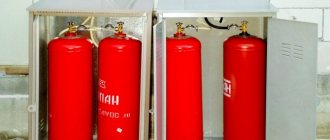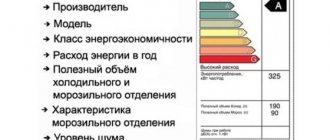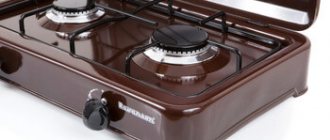- 1 What does GOST say about this?
- 2 Is it necessary to determine the gas consumption of a gas stove per hour? 2.1 Video - Gas supply, gearbox design
The need to install gas meters has increased in the context of widespread gasification. In turn, this need has presented homeowners with a new task - to learn how to carry out the correct calculations to select the appropriate model of metering device. And one of the most important points in the calculations is the consumption of a gas stove per hour, including the indicators of other equipment operating on gas. This is what we will discuss in today’s article.
Why do you need to know gas consumption?
Household meters are used to know how much blue fuel was consumed over a certain period. But in order to install a meter, you must initially know how much blue fuel is consumed per month. It is not the average indicators that are taken into account, but the maximum parameters. For example, if hot water is turned off in the house and you will have to often use the kitchen stove to heat it.
What is this data for? It’s very simple - each meter is designed for a certain amount of fuel consumed. If the power of the stove is small and there are no other devices or appliances in the house that run on gas, you can get by with the simplest and most inexpensive meter. If a water heater and individual heating are additionally used, the throughput of the meter should be much greater. You will also need to replace the gas pipeline pipes, choosing a configuration with a larger diameter.
How to calculate household gas consumption by power so that you can choose the “right” meter?
These data are given in the instructions for the stove. If documents are lost or problems arise with translating the data specified in the passport for kitchen appliances, you can use average indicators: a 4-burner stove consumes 1-1.3 m³/hour.
Information in GOST
Information about burner power is strictly regulated by GOSTs, and if the stove has the appropriate certificates and is approved for installation in an apartment or residential building, it must comply with these parameters. Thus, in residential buildings it is allowed to install gas stoves with 2, 3 or 4 burners, the standard power of which should be:
- 0.6 kW - reduced;
- 1.7 kW - average;
- 2.6 kW - high.
Information on burner power is in GOST
Additionally, it is worth calculating the power of the oven, the average performance of which is within 2.5 kW.
The final parameters will be about 10 kW. Many people ask how they can increase the power of a gas burner if it is insufficient or if they need to switch the stove from liquefied gas to the mains. Despite the fact that many experts give advice on how to do this correctly and what manipulations should be carried out with the valves, the burner itself, and the reducer, all these methods are illegal and unacceptable in relation to gas appliances. Such re-equipment can lead to accidents at home and huge fines from the gas service. If the power of the stove is insufficient, the equipment must be replaced with a new one.
Rules for determining flow
It is almost impossible to determine how much gas will be spent per hour, day, month, since there will be too many variables in the finished formula:
- number of people living in the apartment (house);
- culinary preferences (dumplings are cooked for 15 minutes, cooking cutlets will take about 1 hour);
- using burners at full or half power;
- season;
- use of cookware with different thermal conductivities.
It is almost impossible to determine how much gas will be spent
Taking all this into account, it is only possible to find out how much gas a gas stove consumes per month, hour or other period of time only very approximately.
How to determine the gas consumption of a gas stove per hour
How to correctly calculate gas consumption in m³, knowing only the power of the burners? To do this, the total power of the stove is divided by the thermal conductivity of the gas (average values 8-11 kW*hour/m³).
If, as an example, we take a stove with average burner power ratings of 0.6 kW (1 piece), 1.7 kW (2 pieces) and 2.6 kW (1 piece), then the gas consumption per hour will be:
- 6.6/9.5=0.7 m³
If we take the gas oven into account, we get the following data:
- (6.6+2.5)/9.5=0.95 m³
These calculations are conditional and imply simultaneous operation of all 4 burners at full power for 1 hour (+ oven). The actual parameters of gas consumption can always be found out by the meter, which records the amount of blue fuel used.
Planning meals on a hike
Since cooking almost all hot dishes on a camping trip requires boiling water (for example, cereals, tea, sublimates), the first step in estimating fuel consumption will be to determine how much boiling water we need for each cooking.
The first thing to do is . Find out how long it takes to boil 1 liter of water on your burner. You can use the characteristics of the burner (many manufacturers indicate), but I strongly recommend finding out this by experience. The thing is that a lot also depends on your boiler and the quality of the gas. It is this figure that we will continue to use to calculate fuel needs. Mine, for example, boils a liter of water in 3 minutes. 30 sec.
Make a detailed plan. Do you plan to use the burner for dinners or will you be making cold snacks? Your freeze-dried meal may serve 2 people in one meal, or you may need to double the portion to compensate for the lost calories. Will you use water or will you have to melt the snow? To make it easier to determine the amount of gas needed, we recommend creating a table like this.
| Day of the week | Reception | Food | Quantity of water |
| Friday | Dinner | Freeze-dried soup | 0.5 l |
| Saturday | Breakfast | Oatmeal (5-minute), coffee | 0.5 l |
| Dinner | Lard, cheese, bread, chocolate | 0 l | |
| Dinner | Sublimate “puree with meat”, cocoa | 1 l | |
| Sunday | Breakfast | Buckwheat flakes, coffee | 0.5 l |
| Dinner | Lard, bread, sherbet, nuts | 0l | |
| Total: 2.5 liters |
One counter or several?
It would seem that the answer is obvious. Two meters require additional financial costs for installation, design and purchase of the device itself. On the other hand, the presence of a second meter is justified if the house, in addition to a gas stove, also uses other equipment that runs on blue fuel. At the same time, the difference in average gas consumption indicators is very large and metering devices are not able to cover such a range. It will either not capture the minimum values (0.3 m³/h), or will not cope with high loads (more than 7-8 m³/h). And then a second metering device becomes a necessity.
The choice of suitable meters depends on the maximum (not minimum) power of the household appliance. Metering devices have special markings that help you select a device with the most suitable operating parameters. A meter marked G1.6 or G2.5 is suitable for a stove, and the gas consumption of a boiler and geyser will be calculated by a meter marked G4 or more.
Important: if, in addition to the stove, you use a double-circuit boiler, and not two separate devices for heating and water heating, you will not need a second meter.
Features of installation of the accounting device
The rules for installing a gas meter are very simple - this work should only be performed by a specialist. His tasks include:
- Selecting a location for installing the meter. It should be taken into account that the meter must be located at a certain distance from the heating elements and be accessible for taking readings and performing installation and dismantling work;
- Direct installation of the meter;
- Sealing the metering device.
Installed gas meter
About gas meters
Having calculated the flow rate, we can begin to select a meter model. It is very important to select it in accordance with the power of gas appliances in order to avoid inaccuracies in recording the results of the gas used. In this case, the gas meter will have to be replaced, which means additional costs for the purchase of a new meter and the installation fee.
The power index of the meter is denoted by the letter G. If you only use a stove, without a boiler and a water heater, then, knowing that your device can consume no more than 2.5 cubic meters of gas, choose a G1.6 meter, or, as a last resort, G2 .5, but no more.
If you use blue fuel to heat your home, heat water, and cook food, then problems may arise with choosing a gas meter. After all, the minimum consumption will be 0.3 cubic meters per hour (when you use only one stove), and the maximum - 7.1 cubic meters per hour (when you start heating batteries and water for washing with gas in winter). A meter with index G, capable of giving accurate readings over such a huge range, simply does not exist in nature. So, in this case, you will most likely have to install two meters of different power - separately on the boiler with a column and separately on the stove. It’s a shame, because you’ll have to pay twice for installing a gas meter, get two personal bills and pay for each of them separately.
If the house has a gas stove and a double-circuit boiler, then the power range will not be so striking, because the boiler and heater cannot work at the same time, because they have one common burner. This means that it will be possible to select a meter of appropriate power, and there will be no need to install a separate gas meter on the stove.
If you have a small family and don't cook much, replace your four-burner stove with a two- or three-burner stove. Then you can save money by purchasing a less powerful meter.
Tips for saving gas
Despite the fact that payments for blue fuel used for cooking make up the smallest share of utilities, savings are never superfluous. The desire to reduce costs, regardless of what gas is used in the gas stove, is completely justified, especially since they do not require any special effort:
- If you cover the dishes with a lid, the water in it will not only boil faster, but you will save gas on average by 20%. This method is effective when preparing any dishes;
- The bottom of the pan should be slightly larger than the flame of the burner. In this case, the heat is not wasted;
- If the recipe does not require gradual heating, the contents of the pan must be brought to maximum temperature as quickly as possible. Otherwise, significant heat loss occurs through the walls of the dish;
- Drafts and air conditioners blow the flame aside, increasing the heating time and gas consumption of a gas stove, by an average of 10-15% per hour;
- Do not use the stove for longer than required. This applies to a boiling kettle, a hot frying pan, and boiled eggs. When preparing some dishes, it is recommended to turn off the gas a little earlier than the food is ready. For example, when preparing cereals and pasta.
Watch a video about installing a gas meter
Mains gas for heating needs
The use of gas as an energy carrier for the operation of the heating system is advantageous from all sides. First of all, they are attracted by the quite affordable tariffs for “blue fuel” - they cannot be compared with the seemingly more convenient and safe electric one. In terms of cost, only available types of solid fuel can compete, for example, if there are no special problems with the procurement or purchase of firewood.
In a word, if it is possible to choose this particular method of heating your home, then there is hardly any doubt about the advisability of installing a gas boiler.
In terms of efficiency and ease of use, gas heating equipment currently has no real rivals.
It is clear that when choosing a boiler, one of the key criteria is always its thermal power, that is, the ability to generate a certain amount of thermal energy. To put it simply, the purchased equipment, according to its technical parameters, must ensure the maintenance of comfortable living conditions in any, even the most unfavorable conditions.
This indicator is most often indicated in kilowatts, and, of course, is reflected in the cost of the boiler, its dimensions, and gas consumption. This means that the task when choosing is to purchase a model that fully meets the needs, but, at the same time, does not have unreasonably inflated characteristics - this is both disadvantageous for the owners and not very useful for the equipment itself.
When choosing any heating equipment, it is very important to find the “golden mean” - so that there is enough power, but at the same time - without completely unjustified overestimation
It is important to understand one more point correctly. This is that the specified nameplate power of a gas boiler always shows its maximum energy potential. With the right approach, it should, of course, slightly exceed the calculated data for the required heat input for a particular house. In this way, the same operational reserve is laid down, which may someday be needed under the most unfavorable conditions, for example, during extreme cold, unusual for the area of residence.
Will this capacity be fully utilized? – it’s quite possible that not. But its supply does not look excessive.
Why is all this explained in such detail? But only so that the reader becomes clear on one important point. It would be completely wrong to calculate the gas consumption of a specific heating system based solely on the equipment’s nameplate characteristics. Yes, as a rule, the technical documentation accompanying the heating unit indicates the energy consumption per unit of time (m³/hour), but this is again a largely theoretical value.
It is not advisable to use certified gas consumption values as a basis for calculations, since they will not show the real picture.
Often, passports indicate a consumption range - the boundaries of minimum and maximum consumption are indicated. But this probably will not be of great help in calculating real needs.
But it is still very useful to know gas consumption as close to reality as possible. This will help, firstly, in planning the family budget. Well, secondly, the possession of such information should, willingly or unwillingly, stimulate zealous owners to search for reserves of energy savings - perhaps it is worth taking certain steps to reduce consumption to the possible minimum.
So, the starting point for determining gas consumption for heating needs should still be the thermal power that is required for these purposes. Let's start our calculations with it.
If you look through the mass of publications on this topic posted on the Internet, you will most often find recommendations to calculate the required power based on the area of the heated premises. Moreover, for this a constant is given: 100 watts per 1 square meter of area (or 1 kW per 10 m²).
Comfortable? - undoubtedly! Without any calculations, without even using a piece of paper and a pencil, you perform simple arithmetic operations in your head, for example, for a house with an area of 100 “squares” you need at least a 10-watt boiler.
Well, what about the accuracy of such calculations? Alas, in this matter everything is not so good...
Taking the axiom that 100 W of heat is required for every meter of area as a basis for calculating heating power is not a completely serious approach.
Judge for yourself.
For example, will the thermal energy requirements of premises of the same area, say, in the Krasnodar Territory or regions of the Server Urals be equivalent? Is there a difference between a room bordering on heated premises, that is, having only one external wall, and a corner one, and also facing the windward north side?
So, there is no doubt that the required amount of thermal energy for heating a room is influenced not only by its area - it is necessary to take into account a number of factors related to the characteristics of the region and the specific location of the building, and the specifics of a particular room. It is clear that rooms within even the same house can have significant differences.
READ MORE: Errors in Baltgaz gas boilers: fault codes and troubleshooting methods
Each room may have individual characteristics, so it is advisable to carry out calculations for the rooms separately, and at the end - to summarize the total
The proposed calculation algorithm does not claim to be a professional calculation, but has a sufficient degree of accuracy, proven by practice. To make the task extremely simple for our readers, we suggest using the online calculator below, the program of which has already included all the necessary dependencies and correction factors. For greater clarity, brief instructions on how to perform the calculations will be provided in the text block below the calculator.
Go to calculations
So, we will count for each room separately in approximately this sequence
- We start with the area of the room. And we will still take the same 100 W per square meter as the initial value, but many correction factors will be introduced as the calculation progresses. In the input field (using the slider) you must indicate the area of the room, in square meters.
- Of course, the required amount of energy is influenced by the volume of the room - for standard ceilings of 2.7 m and for high ceilings of 3.5 ÷ 4 m, the final values will differ. Therefore, the calculation program will introduce a correction for the height of the ceiling - you must select it from the proposed drop-down list.
- The number of walls in the room that are in direct contact with the street is of great importance. Therefore, the next point is to indicate the number of external walls: options are offered from “0” to “3” - each value will have its own correction factor.
- Even on a very frosty, but clear day, the sun can affect the microclimate in the room - the amount of heat loss is reduced, direct rays penetrating the windows sensitively heat the room. But this is typical only for walls facing south. As the next data entry point, indicate the approximate location of the external wall of the room - and the program will make the necessary adjustments.
“Frost and Sun – a wonderful day...” - it really is! The sun's rays, even in winter, are quite capable of influencing the microclimate in a room facing south
- Many houses, both country and urban, are located in such a way that the outer wall of the room is windward most of the winter. If the owners know the direction of the prevailing winter wind rose, then this circumstance can be taken into account in the calculations. It is clear that the windward wall will always cool more strongly - and the calculation program calculates the corresponding correction factor. If there is no such information, then you can skip this point - but in this case, the calculation will be carried out for the most unfavorable location.
If the prevailing direction of winter winds is known, then this circumstance can be taken into account in the calculations
- The next parameter will adjust for the climatic specifics of your region of residence. We are talking about temperature indicators that are typical in a given area for the coldest ten days of winter. It is important that we are talking specifically about those values that are the norm, that is, they are not included in the category of those abnormal frosts that every few years, no, no, and even “visit” any region, and then, due to their atypicality, remain for a long time in memory.
It is necessary to indicate those indicators of minimum winter temperatures that are the norm for a given region
- The level of heat loss is directly related to the degree of thermal insulation of the walls. In the next data entry field, you must evaluate it by choosing one of three options. At the same time, a wall can be considered fully insulated only if thermal insulation work has been carried out in full, based on the results of thermal engineering calculations.











